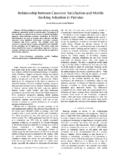Transcription of Bamidele Relationship Credit & Microenterprise
1 The Relationship between Credit Characteristics and Microenterprise performance : A Brief Analysis by Adekunle Bamidele1. This paper presents the Relationship between financial institutions and Microenterprise development. The impact of microfinance institutions on microenterprises and why some of them encourage entrepreneurial development is explored through the development of a conceptual framework. The paper posits that financial intermediation through an interdependent society might encourage entrepreneurial and Microenterprise development. Introduction Microenterprises represent a significant portion of business activity in developing countries.
2 The only reason why people underestimate the magnitude of Microenterprise is because most of these businesses are not registered. A house-to-house survey in Zimbabwe by Liedholm and Mead (1999) indicate that the number of medium and small enterprises in developing countries is far greater than official statistics. They further state that the range of activities of Microenterprise are small and mostly involve self- employment. The labour force comprises mostly the proprietors and unpaid family labour; at times hired labour is employed but this accounts for only 20 percent of the labour force of microenterprises in Zimbabwe.
3 In some studies undertaken on Microenterprise it has been argued that one-person enterprise generates the lowest return, thus an increase in the size through the increase in workers leads to significant increase in economic efficiency (Parker 1994; Cabal 1995; Lieldholm and Mead 1999). A major 1. Adekunle Bamidele is a Research Associate at Department of Capacity Development and Extension, School of Environmental Design and Rural Development, University of Guelph. Tel: 5193419632. Email: barrier to enterprise performance is finance. Thus, this paper presents the implication of the source of Credit on entrepreneurship and Microenterprise development.
4 Microenterprise Development The problems that constrain the development of microenterprises in developing countries are markets for the product they sell, access to inputs required for these products, finance and lack of incentives and norms that generate a propensity for entrepreneurial discovery (Liedholm and Mead 1999; Walker and Weigall 2001; Co 2003; Still 2005; Marlow 2005). Other barriers to continual Microenterprise growth identified in the literature include structural and socioeconomic conditions, increasing competition, and lack of microentrepreneur business skills and understanding.
5 According to Zeller et al (1997), member-based institutions at the community level, such as Credit groups, can be built on and make use of the principles of informal finance by using locally-available information and social contacts in enforcing contracts. Thus, a good institutional framework is required to create an enabling environment for Microenterprise development. Impact of Microfinance Capital in the form of money is crucial for entrepreneurial development. This is enunciated by Harper (2003), who contends that one way money affects entrepreneur's agency belief is through its impact on their perception of their problem situation.
6 An entrepreneur's estimates of self-efficacy and degree of agency may include a cognitive appraisal of the situational context in which entrepreneurship occurs, including the nature of the goals to be achieved and the requirements of transactions to be carried out. The challenge is that economists have not analyzed the role of financial institutions such as 1. Cooperative Thrift and Credit Societies on agency belief, entrepreneurship and Microenterprise development. Zeller (1997) suggests that the success of rural finance programs can be measured using three criteria. These are i) the coverage of the poor and their demand for financial services; ii) accessibility, particularly equal gender access to the program; and iii).
7 Financial viability and sustainability in providing the service. The major microfinance institutes in sub-Saharan Africa are Commercial or Development Banks, Moneylenders, Rotatory Savings, Non-Governmental Organizations, Cooperative Thrift and Credit Societies, friends and relatives. According to Zeller (1997) these institutions have different characteristics when it comes to production Credit , consumption/social Credit , extension services, savings mobilization, and risk coverage, which measure the coverage of the poor. Accessibility can be measured using formal or informal institutions, gender orientation, minimum balance, membership fee, collateral requirement, and formal/informal sector linkage.
8 Subsidization, covering administrative costs, recovery rates, year of establishment and growth can also be used to measure financial viability and sustainability. Institutional economics has gone a step further by stating that the three benchmark measures of impact are real receipt, client longevity and graduation schedule (Mercatus Centre 2003): Real Receipts: This measures the real receipts of the organization (that is payment versus loan paid out). Unlike repayment rate it takes into consideration inactive or unpaid loans from the books. Client Longevity: This reports lost clients as a percentage of total clients.
9 2. Graduation Schedule: This tracks the number of clients receiving different sized loans, how many of them are first-time or repeat recipients and the number of loans at each level as a total percentage of the overall portfolio. Conceptual Framework Economic evaluations of enterprise development have typically focused upon resource endowments, including stocks of physical and human capital and technological knowledge. Little or no attention has been paid to the role of entrepreneurship and the capacity of institutions like Cooperative Thrift and Credit Societies to promote entrepreneurship. Entrepreneurship is the basis of economic development and growth (Schumpeter 1934; Coase 1937; Baumol 1968; Leibenstein 1968; Nafziger 1977; Kirzner 1997; Harper 2003; Van Praag 2005).
10 It causes continuous disequilibria in the market that creates opportunity for value creation in the market and affects firms' responsiveness to new market conditions (Kirzner 1997). This paper presents the institutional context in which entrepreneurial processes are manifested. A blended-value approach was used in the development of a framework for this paper. According to the blended value approach, all investments are understood to operate simultaneously in both economic and social realms (Emerson 2000). There is no trade-off between the two rather a concurrent pursuit of value both social and financial.







